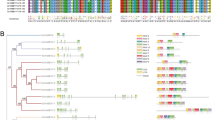Abstract
Based on genetic and molecular analyses, the ABC model has been proposed to explain the genetic control of floral development. C-class MADS-box genes play crucial roles in Arabidopsis thaliana development by regulating the organ identities of stamens and gynoecium. The present research reports for the first time the cloning of an HpSHP gene from Hosta plantaginea (Lam.) Aschers. Phylogenetic analysis shows that HpSHP is a member of the C-class MADS-box genes that is closely related to C-lineage SHP homologues from monocot species. Semi-quantitative and real-time polymerase chain reaction analyses show that HpSHP expression is stamen and gynoecium specific. HpSHP also has spatial and temporal expression patterns in the reproductive organs of H. plantaginea. A functional analysis is carried out in Arabidopsis by overexpression of HpSHP. Homeotic transformations of sepals into carpelloid organs, bent ovaries, and prematurely shattering fruits are observed in 35S::HpSHP transgenic plants. All these results show that HpSHP plays a crucial role in gynoecium development.




Similar content being viewed by others
References
Skipper M, Johansen LB, Pedersen KB, Frederiksen S, Johansen BB (2006) Cloning and transcription analysis of an AGAMOUS- and SEEDSTICK ortholog in the orchid Dendrobium thyrsiflorum (Reichb. f). Gene 366:266–274
Honma T, Goto K (2001) Complexes of MADS-box proteins are sufficient to convert leaves into floral organs. Nature 409:525–529
Kramer EM, Jaramillo MA, Di Stilio VS (2004) Patterns of gene duplication and functional evolution during the diversification of the AGAMOUS subfamily of MADS box genes in angiosperms. Genetics 166:1011–1023
Causier B, Castillo R, Zhou J, Ingram R, Xue Y, Schwarz-Sommer Z, Davies B (2005) Evolution in action: following function in duplicated floral homeotic genes. Curr Biol 15:1508–1512
Pinyopich A, Ditta GS, Savidge B, Liljegren SJ, Baumann E, Wisman E, Yanofsky MF (2003) Assessing the redundancy of MADS-box genes during carpel and ovule development. Nature 424:85–88
Ren J, Sun L, Wang CL, Zhao SL, Leng P (2011) Expression analysis of the cDNA for magnesium chelatase H subunit (CHLH) during sweet cherryfruit ripening and under stress conditions. Plant Growth Regul 63:301–307
Song H, Liu D, Chen X, Ying ZH, Zhang B, Li FL, Lu H (2010) Change of season-specific telomere lengths in Ginkgo biloba L. Mol Biol Rep 37:819–824
Yang Y, Fanning L, Jack T (2003) The K domain mediates heterodimerization of the Arabidopsis floral organ identity proteins, APETALA3 and PISTILLATA. Plant J 33:47–59
Flanagan CA, Hu Y, Ma H (1996) Specific expression of the AGL1 MADS-box gene suggests regulatory functions in Arabidopsis gynoecium and ovule development. Plant J 10:343–353
Alvarez J, Smyth DR (1999) CRABS CLAW and SPATULA, two Arabidopsis genes that control carpel development in parallel with AGAMOUS. Development 126:2377–2386
Favaro R, Pinyopich A, Battaglia R, Kooiker M, Borghi L, Ditta G, Yanofsky MF, Kater MM, Colombo L (2003) MADS-box protein complexes control carpel and ovule development in Arabidopsis. Plant Cell 15:2603–2611
Acknowledgments
This work was supported by the National Natural Science Foundation of China (Grant No. 31170574), the fundamental research funds for the central universities (HJ2010-8 and BLJC200907) and the Program for New Century Excellent Talents in University (NCET-08-0730).
Author information
Authors and Affiliations
Corresponding author
Additional information
Guodong Rao, Ying Wang contributed equally to this work.
Rights and permissions
About this article
Cite this article
Rao, G., Wang, Y., Zhang, D. et al. Isolation and characterisation of an HpSHP gene from Hosta plantaginea . Mol Biol Rep 39, 6887–6894 (2012). https://doi.org/10.1007/s11033-012-1515-1
Received:
Accepted:
Published:
Issue Date:
DOI: https://doi.org/10.1007/s11033-012-1515-1




